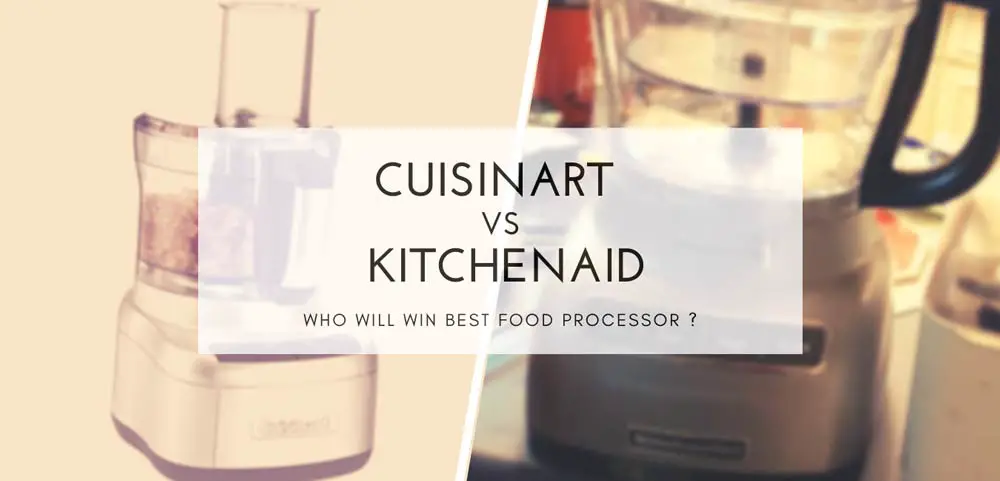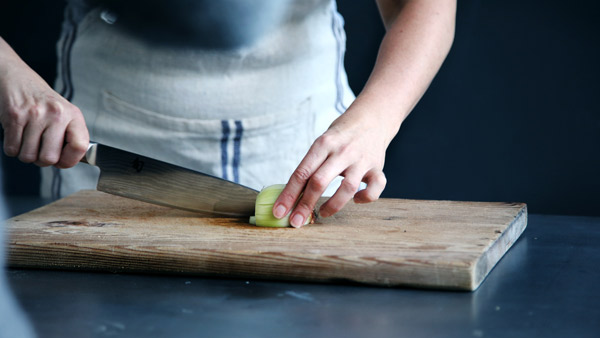A good food processor can take your culinary adventures in the kitchen from basic to professional in the very first whirl of its powerful blades.
Not all food processors are created equal, however. They can vary in size, price, and power.
A food processor can do so much more than whip up a perfect smoothie. You can use them to make homemade salsa, pesto, nut butters, pie crusts, and even baby food—so you want to invest in one durable enough to last.
In this article, we’ll pit two of the top brands against each other. Cuisinart Versus Kitchenaid food processor.
Ready to find out who wins? Let’s dive into this ultimate kitchen showdown!
Cuisinart versus. KitchenAid: The brands
You’re likely already familiar with both Cuisinart and Kitchenaid, but which brand food processor is best? You may be wondering: “Is Cuisinart better than Kitchenaid?” For fun, let’s look at a bit of their history!
While Kitchenaid has been in the home appliance game around 50 years longer than Cuisinart, Cuisinart was started specifically to bring an electronic food processor onto the scene. As such, despite their long list of quality products, Cuisinart is still best known for food processors while Kitchenaid’s leading star is their standing mixers.
When it comes down to which company’s food processor is best, it really depends on several factors. Some people swear by their Cuisinart while others are Team Kitchenaid. No matter which way you slice it—both companies lead the market on food processors.
The good news is, whichever brand you purchase, you’ll have a quality machine on your hands! Let’s look at those several factors and address any questions you may have to better steer you toward purchasing the perfect food processor for your home kitchen.
Do chefs use food processors?
You bet they do! Even though they’re masters of hand-chopping mounds of fresh vegetables, chefs enjoy using powerful food processors to save valuable prep time in the kitchen.
Just like a professional chef, you can save time and redundant work by using a good food processor. They’re so powerful—it’s like having several different appliances in one!
If you’re wondering “are food processors worth buying?” Our answer is—YES. We believe in anything that saves you time and energy in and out of the kitchen.
What is the difference between a food chopper and a food processor?
Let’s clear this question up first. The largest (and most obvious) difference between the two is size.
A food chopper is small and often handheld—though electric versions exist—they hold 1-4 cups worth of food at a time. Most people use them to chop nuts, fruits, or onions for salad toppings.
Pros
Cons
A food processor is quite a bigger beast! Depending on the processor, these babies can handle up to 12 cups of food at a time. Also, they come with all different blades meaning you can do so much more than simply “chop.”
Pros
Cons
What do you use a mini food processor for?
Now that we’ve covered differences between choppers vs food processors, you may be wondering “what about those mini food processors?”
Glad you asked!
Mini processors fall perfectly in between the previous examples. They usually hold around 3-4 cups of food. They have the perks of being smaller, lighter, and less expensive just like a food chopper. But they boast more power and the ability to both chop and grind like a food processor.
If you’re wondering how to use your small Kitchenaid or Cuisinart food processor, we’ve got a few suggestions up our sleeves. Grab your apron!
You can use your mini food processor to:
- Chop just one onion or a few cloves of garlic
- Whip up a tasty, healthful salad dressing
- Make a single-serving of guacamole
- Homemade breadcrumbs
- Small batches of pesto and hummus
- Grinding herbs for your own spice blends
There are many delicious possibilities as you can see!
So what is the best mini food processor?
In our opinion, these two highly-rated mini food processors by Cuisinart are the best.
First up is the Cuisinart CH-4DC 4-Cup Chopper/Grinder, it’s slightly larger.
Then we have the Cuisinart DLC-2ABC Mini Prep Food Processor, it does 3-cups of work at a time.
It gets better! They both include dishwasher-safe parts, a spatula, and a recipe/instruction book.
Or if you’re firmly Team Kitchenaid, we also like the KitchenAid KFC3516ER 3.5 Cup Mini Food Processor.
It boasts an easy-pour spout. Perfect for drizzling homemade salad dressings over your meal!
What should I look for when buying a food processor?
This is the ultimate question. Here are some things to consider before you go shopping.
First, establish what size you need. To figure this out, think about what sort of foods you wish to prepare using your food processor. Do you want it to be capable of shredding cheese or mixing dough? Do you have a large family to feed or is it just two of you?
Generally speaking, if you have a family of four people you’ll want at least a 10-cup size food processor. If you tend to cook larger meals or like to make extra food to store, consider jumping up to the 14 or even 16-cup size.
The next thing to think about? Food processors vary in wattages. If you’re looking for basic cutting and chopping, a low wattage will do you. If you’re like me though—you want the POWER! Anything over 700 watts should be able to handle it all, including dough mixing.
All that power doesn’t mean much if your blades aren’t up to snuff. Look for a food processor that offers several types of blade options to puree your way to kitchen bliss. Also, double-check what those blades are made of. Material matters and stainless steel is your best friend.
Finally, keep an eye out for that warranty, especially if you go for a pricier machine. Home appliances have a standard warranty of 1 year, but Cuisinart will usually cover several years.
Armed with this knowledge, you should easily be able to figure out which is the best food processor to buy for home use.
Can a KitchenAid be used as a food processor?
Actually, yes! If you don’t want to buy an entirely new appliance, Kitchenaid makes an attachment for your standing mixer.
It simply attaches to the hub on the front of your mixer and you’re ready to slice, dice, shred, and julienne!
If you’re still asking “what does a KitchenAid food processor do?” You’d get a shorter answer if you asked instead: “what does it not do?!”
Cut to the chase please, what is the best food processor on the market?
When it comes to the ultimate answer to the big question of is Cuisinart or KitchenAid’s food processor better, we’re still standing firm in our noncommital answer of “it depends.” That’s why we’re going to now closely compare one of each brand’s leading models.
The Cuisinart Elemental 13-cup and the Kitchenaid Pro Line Series 16-cup.
Now here’s a handy chart of key features for our superstar food processors:
Brand | Model | Seal | Speed Options | Blades | Warranty | Price |
|---|---|---|---|---|---|---|
Cuisinart | FP-13DGM | SealTight Advantage System | High/Low/Pulse | 7 | 3 years | |
Kitchenaid | KFP1642MS | UltraTight Seal w/ Leak-Resistant Ring | High/Low/Pulse | 5 | 5 years |
*Use the check price links to find out how much the Kitchenaid and Cuisinart food processors costs.
Both the Cuisinart and the Kitchenaid boast tight-fitting seals, 3 speeds, multiple blades for shredding, slicing, dicing, mixing, and a dough blade. The Kitchenaid may be more expensive, but they have a bigger working bowl and will cover a longer warranty period. They both have several color options to choose from as well.
These food processors are up for any kitchen challenge you throw their way. They have ultra wide-mouth feed tubes to accommodate even extra-large vegetables like potatoes. They even include three differently-sized pushers to go with the feed tube (small, medium, and large).
And bonus! They both come with storage cases for their accessories. No more interrupting your workflow to search around in frustration for the part you need.
With either machine you will be able to:
- Shred cheese
- Chop nuts or fruit
- Mix and knead dough for bread or pies
- Dice onions and peppers
- Make your own cauliflower “rice”
- Slice potatoes
- Grind meat
And so much more!
It truly is amazing how easy a food processor makes it for you to cook healthy meals at home. Investing in a food processor is really investing in your health and longevity because a food processor will help you cut back on the amount of processed food you eat.
If you don’t feel like you need the big 16-cup working bowl, you can instead go for the Kitchenaid 7-cup food processor—it works the same way.
In your opinion, who won the Cuisinart Vs Kitchenaid showdown? There are no wrong answers!
Troubleshooting: Why is my KitchenAid (or Cuisinart) food processor not working?
Is it plugged in? Just teasing! (Though maybe still check that cord out first.) In this section, we’ll cover three of the most common culprits for when your food processor isn’t working.
1. Examine the work bowl and lid of your food processor. If these parts aren’t locked in to place properly the appliance will not start.
2. Test if your electrical outlets are working. You can do this by plugging in a different device to see if it powers on.
3. Was the food processor working hard on a food project and then just quit? It’s possibly overheated. Give your culinary buddy a break of at least 15 minutes before attempting to turn it back on.
Note: I know when my food processor doesn’t start it has always been because I didn’t fully lockdown that lid!
You can find further troubleshooting tips for Cuisinart here in their instruction manual. They’ll cover anything we may have missed to help you learn how to make your food processor work.Further troubleshooting tips for Kitchenaid here.
Fully Processed
Hopefully, this article has cleared up any confusion you may have had about food processors and gotten you hyped to go shopping for your very own. Whether you go for a cute mini food processor or a giant 14-cup chopping monster, we just know you’re going to create amazing dishes!
Finally, I use a Cuisinart food processor in my own home kitchen. I’ve had it for five years now and it’s never once given me a lick of trouble. It’s been through three big moves and an ocean voyage! I can honestly answer the question “how does a Cuisinart food processor work?” It works well!
I simply plug it in, fill the working bowl, lock down the lid, and pulse my ingredients until well-combined. I’m not sure how I ever got along without this game-changing kitchen appliance.
I’ve used it to make so many batches of spinach pesto (highly recommend) that I’m honestly surprised it hasn’t turned green! Two of my other favorite recipes to use my Cuisinart food processor to make are almond pulp freezer fudge and cashew cheese. It’s a big culinary world—go explore!







